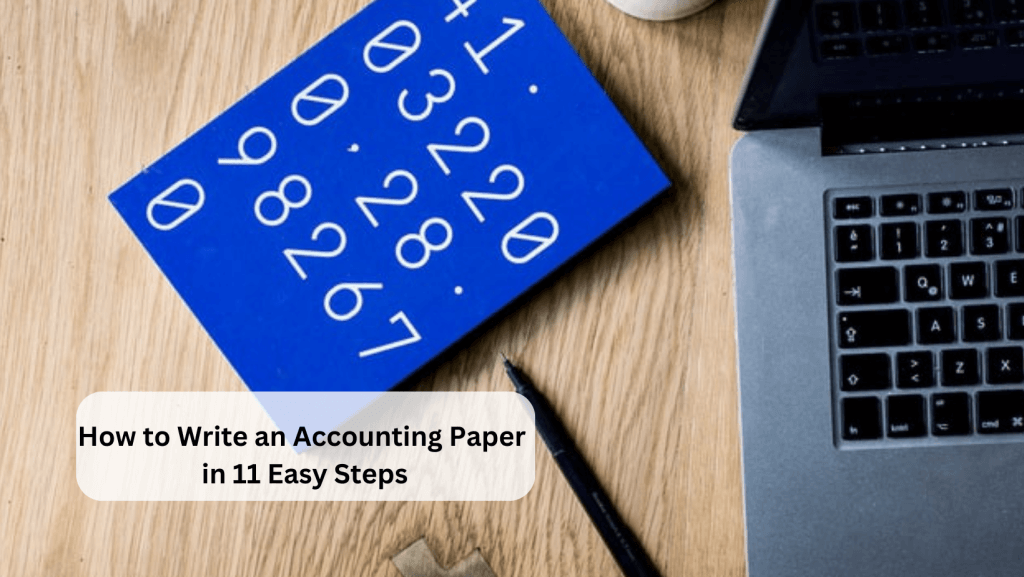Modern accounting requires proficiency in all forms of communication. Senior-level accounting students must submit an accounting paper focused on a specific research topic alongside a well-documented manuscript. As a result, learning how to write an accounting research paper is a worthwhile endeavor in acing accounting tests. However, it’s a challenging task that involves identifying problems, collecting data, and applying theories to real-world situations. Here’s a detailed guide by our accounting professionals on writing a comprehensive accounting research paper. They also help students with their accounting paper assignments and exams.
How to Write a Research-Based Accounting Paper
Writing an accounting research paper is a little different from a normal essay. It requires in-depth analysis, real-world evidence, and a structured approach to address complex accounting topics. Here’s a detailed guide to writing an accounting research paper.
Choose a Topic
Once in a while, the instructor will provide a list of research topics to choose from. Carefully select a relevant and well-defined research paper that interests you for a general requirement paper. Consider relevance, novelty, and potential contribution to the accounting field.
Here’s a list of some common accounting research topics to brainstorm on:
- Accounting for Income Taxes
- Accounting for Stock Options
- Financial Statement Analysis Methodologies
- Management Accounting Techniques
- Tax Formula and Its Components
- Accounting Circle Process
- Current and Non-Current Assets
- Accounting for the Environment
Create a Strategy
Accounting research papers are different. Some require extensive library research, while others are based on interviews, field research, surveys, or original experiments. Here’s a general accounting paper strategy irrespective of the topic.
- Review the assignment to ensure complete understanding and expectations of the task.
- Conduct initial research on your preferred topic to familiarize yourself with basic terms.
- Narrow down the topic and determine the scope of available evidence.
- Formulate questions for source selection and develop a preliminary thesis statement.
- Create a timeline to ensure the timely completion of the research.
- Record information that requires source citation.
- Create an outline as you collect sources to visualize their placement in the research paper.
- Choose the most relevant sources.
- Revise and refine your thesis statement if necessary.
Organize the Research Paper
Organize the research paper to allow readers to access the paper selectively based on their interests. The paper must have a clear structure, comprising distinct sections with appropriate headings and subheadings. Write the thesis statement (hypothesis) before writing other parts of the paper to help you stay focused and ensure a logical flow. Create an outline to help you structure information, ensuring a comprehensive and coherent paper organization.
Create as structure
Research papers vary in format and style across various academic disciplines. However, the structure is almost the same in most papers. Your accounting paper should have the following parts:
Title
It should be brief and specific, clearly stating the paper’s focal problem by incorporating specific keywords.
Abstract
The abstract gives the reader a glimpse of the research paper. Make it brief—200 words. It’s the research paper summary and should be written after completing the research.
Introduction
Introduce the topic and give basic background information. The introduction narrows down to the specific research query, clarifies key terms, and outlines the paper’s scope. In essence, it establishes the paper’s focus and purpose.
Literature Review
The literature review aligns the initial research with the problem being addressed. Review your findings from credible sources such as academic books and journal articles. The methods sections should describe the study’s context, methodology, design, and analysis techniques used.
Your findings section should present the analysis results logically. Include tables, charts, graphs, and pictures to enhance clarity and understanding. Any extra information supporting the analysis but not essential to the findings of the explanations should be added in the appendix.
The discussion section should clearly present your main findings and their implications for readers. Discuss the relation of your findings to the previous research in the literature review. Mention your study’s limitations and conclude the study by offering a perspective for future research.
Reference/ Bibliography
Present all sources used in obtaining research information in alphabetical order. Cite your sources based on the citation style requirements given by the instructor.
Write a Draft
While writing the draft, prioritize content over concerns such as grammar and spelling. Express your ideas clearly, bolstering them with your notes and using the outline. Maintain a clear purpose coherent with the thesis statement or research question.
Revise, Edit, and Proofread
Take a one or two-day break after writing before revising and editing the paper. Ask a friend or family member to read it out for you, noting down the mistakes. Alternatively, send your accounting paper to professional essay writers for more in-depth editing and proofreading.
How to Write an Accounting Research Paper: Final Thoughts
Mastering how to write an accounting paper based on a specific research topic is a strategic skill that takes time to cultivate. Get help from accounting professionals on choosing the right topic, conducting thorough research and analysis, structuring your paper, and curating a comprehensive accounting research paper.




